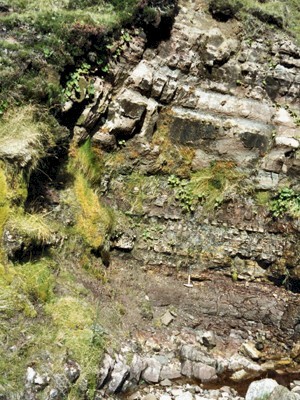Earth Science Conservation Review
| Barony Glen | Londonderry |


| Site Type: | River bank, Stream section |
| Site Status: | local interest |
| Council area: | Limavady Borough Council, Magherafelt District Council |
| Grid Reference: | C732016 |
| Google maps: | 54.85724,-6.86018 |
| Rocks | |
|---|---|
| Rock Age: | Carboniferous (Tournasian) |
| Rock Name: | Altagoan Formation, Drumard Member, Tyrone Group |
| Rock Type: | Limestone, Mudstone, Sand, Sandstone, Siltstone |
| Interest | |
| Other interest: | Fluvial sediments, alluvial plain |
Summary of site:
On the western flank of White Mountain, immediately below the cap of Tertiary basalt lavas, around 100m thickness of horizontal Carboniferous rocks are exposed over a length of 320m of the precipitate stream bed. These are the purplish brown to red mudstones, siltstones and sandstones of the Barony Glen Formation for which this is the type locality and section. At about 350 million years old, these rocks are equivalent in age to the Drummard Member of the Altagoan Formation around Armagh.
The frequent occurrence of carbonate nodules (irregular rounded clots) and thin limestone beds indicate that these were soils periodically invaded by fresh water. They were low lying on an equatorial land surface. There are no fossils evident to the naked eye and the processing of sediment for microscopic fossils has proved fruitless.
This section is the standard reference for the extensive development of rocks of this type and age in the north west of Northern Ireland and as such is fundamental to our understanding of them. There are no evident threats to this exposed upland site.
The frequent occurrence of carbonate nodules (irregular rounded clots) and thin limestone beds indicate that these were soils periodically invaded by fresh water. They were low lying on an equatorial land surface. There are no fossils evident to the naked eye and the processing of sediment for microscopic fossils has proved fruitless.
This section is the standard reference for the extensive development of rocks of this type and age in the north west of Northern Ireland and as such is fundamental to our understanding of them. There are no evident threats to this exposed upland site.
| Enlander, I., Dempster, M. & Doughty, P., 2025. Barony Glen, County Londonderry, site summary. [In] Earth Science Conservation Review. https://www.habitas.org.uk/escr/summary.php?item=301. Accessed on 2025-04-03 |
| Previous Site | Next Site |

